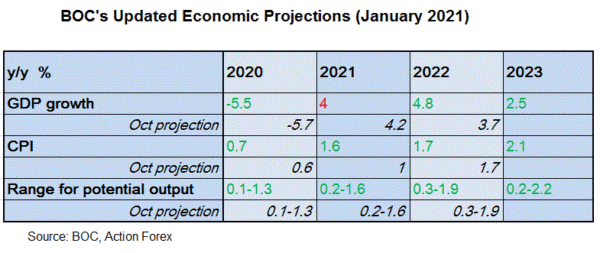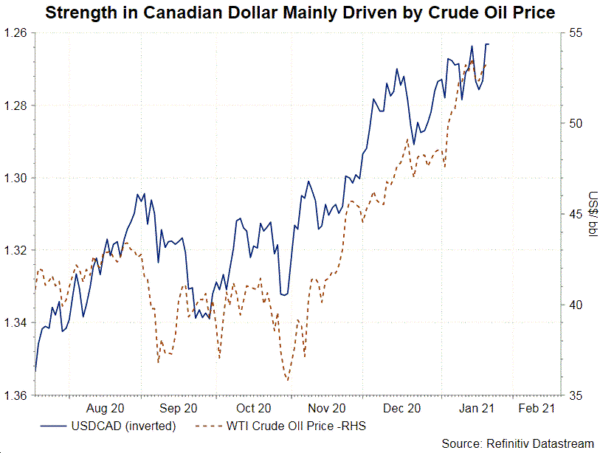BOC’s January meeting came in less dovish than expected. While leaving the monetary policy measures unchanged, the central bank has upgraded the economic outlook for 2022. Meanwhile, policymakers hinted QE tapering if confidence over recovery improves. At the meeting, BOC kept the overnight rate at 0.25% and the QE program a weekly purchase of CAD$4B.
BOC has turned more optimistic over the economic outlook. As suggested in the accompanying statement, “the earlier-than anticipated arrival of effective vaccines will save lives and livelihoods, and has reduced uncertainty from extreme levels”. Meanwhile, it continued to warn that “uncertainty is still elevated, and the outlook remains highly conditional on the path of the virus and the timeline for the effective rollout of vaccines”. On the economic forecasts, BOC revised lower the GDP growth estimate to +4% for this year, from +4.2% projected in October, as the current lockdown measures should affect activities in the first quarter. GDP growth is expected to improve to +4.8% in 2022, compared with October’s projection of +3.7%. The inflation outlook has also been better, with upgrades seen for both this year and 2022. The above forecasts were made under the assumption that “the most severe virus containment measures are lifted in February”. Moreover, “effective vaccine rollout” would “lead to broad immunity by the end of 2021” in advanced economies and China” and “by mid-2022 in other emerging-market economies”.
Turning to the monetary policy, it appears the chance of having a micro rate cut is getting slimmer. As Governor Macklem noted at the press conference, “if the economy turned out to be substantially weaker than our outlook, we have tools, we have options to provide even more stimulus and we’re prepared to use them. Reducing the lower bound from its current level of 25 bps to lower but still positive number is one of those options to provide additional monetary stimulus”. While not explicating refusing lowering the policy rate further, the upbeat economic assessment reveals that such reduction is not likely. On asset purchases, there is a reference in the statement noting that “as the Governing Council gains confidence in the strength of the recovery, the pace of net purchases of Government of Canada bonds will be adjusted as required”. While there is no timeline for QE tapering, the central bank has started to offer some hints regarding this. All in all, the forward guidance remains intact, suggesting that “the Governing Council will hold the policy interest rate at the effective lower bound until economic slack is absorbed so that the 2% inflation target is sustainably achieved. In our projection, this does not happen until into 2023”.
The upbeat economic assessment and policy stance have sent the loonie even higher. Yet, BOC did not seem too worried about it. It largely attributed the strength of Canadian dollar to higher commodity prices and a broadly weaker US dollar. It, however, cautioned that further appreciation could weigh on Canada’s exports.




![Week ahead – ECB set to cut, BoC might pause as Trump U-turns on tariffs [Video]](https://www.actionforex.com/wp-content/uploads/2018/04/f-ecb29-218x150.jpg)








